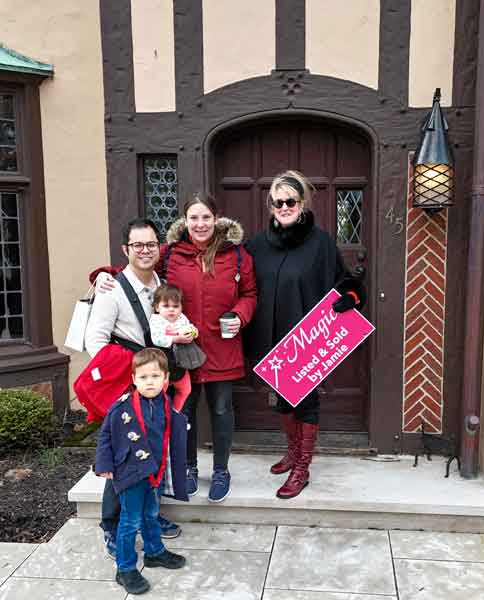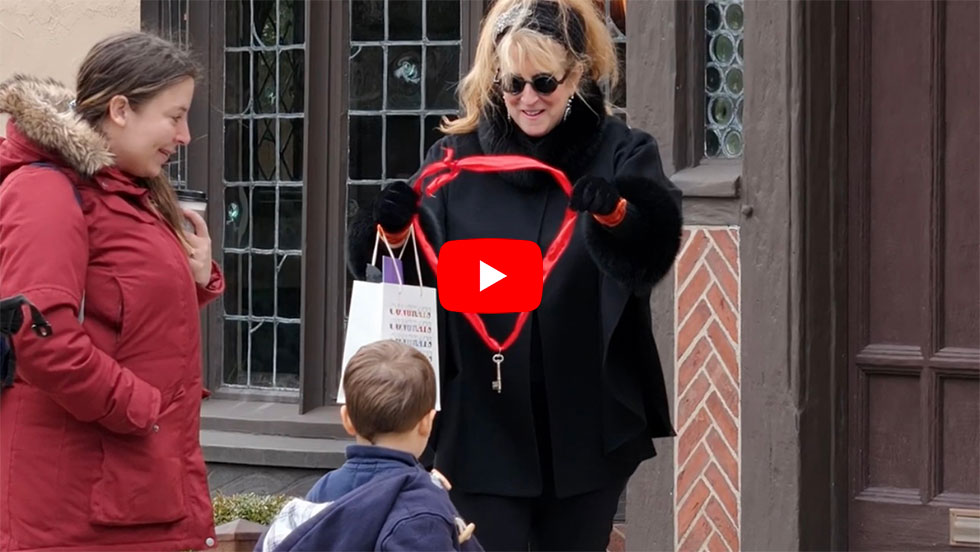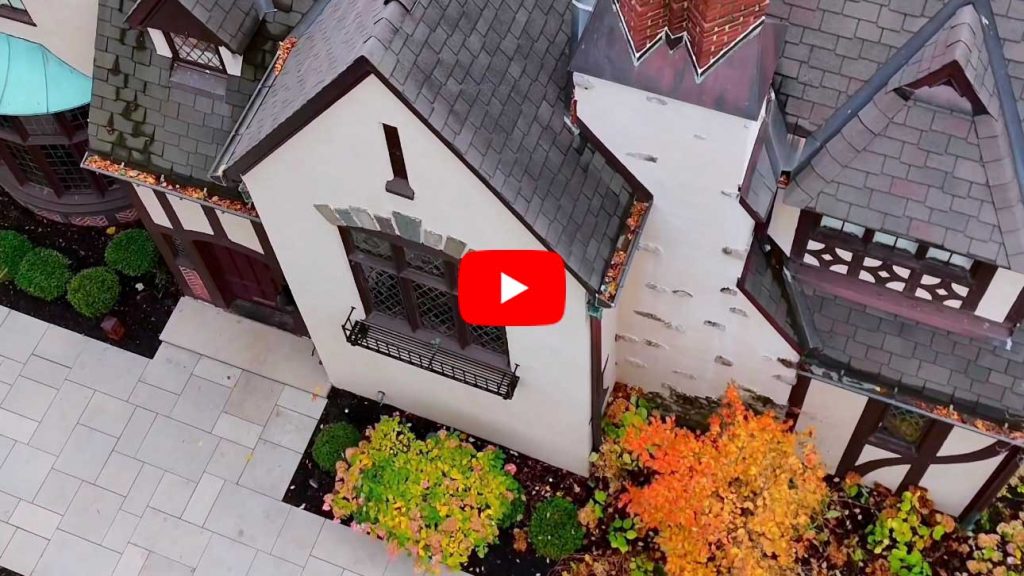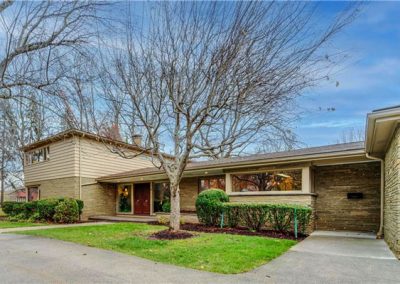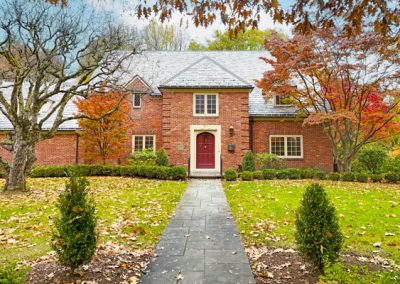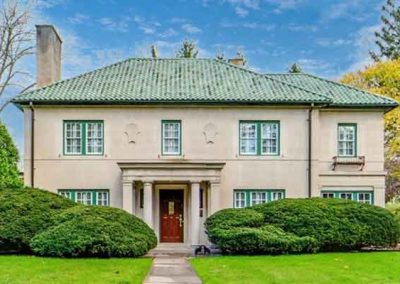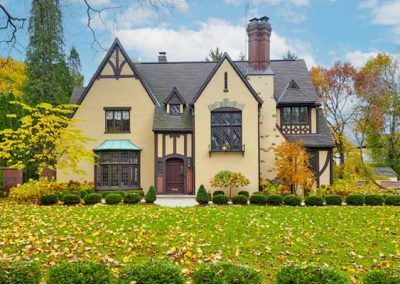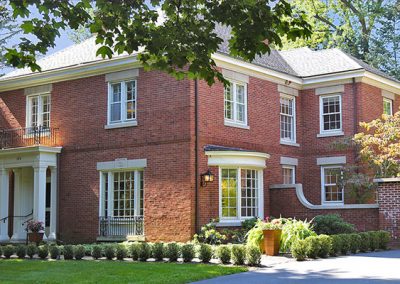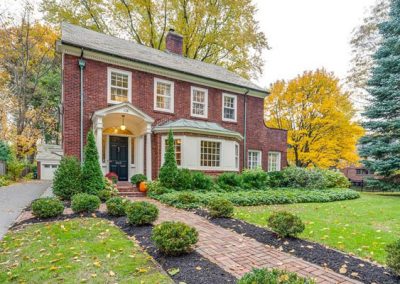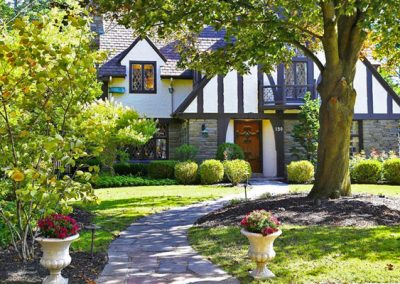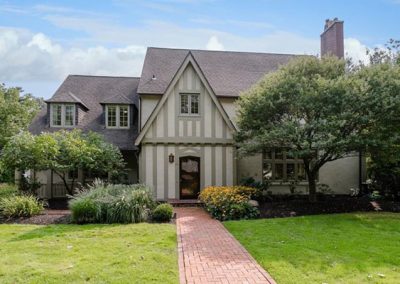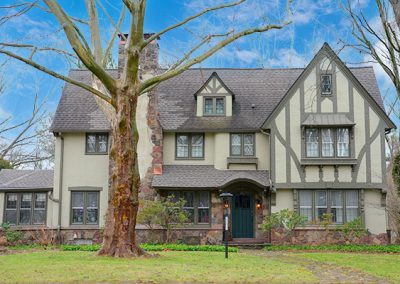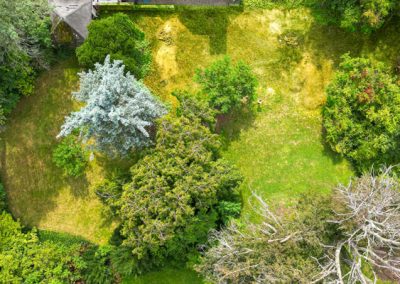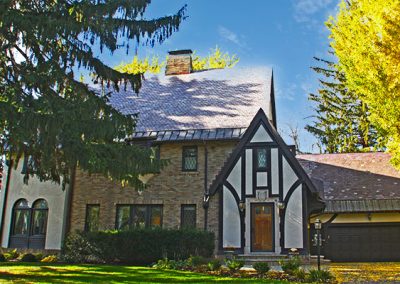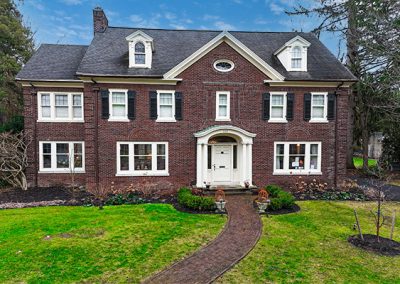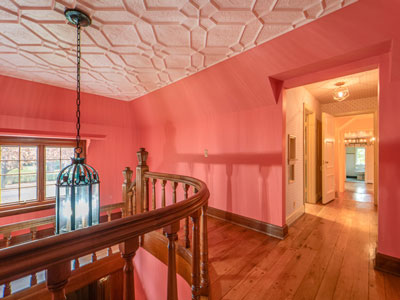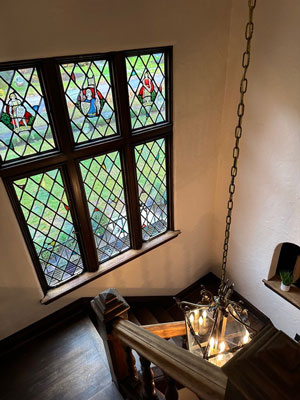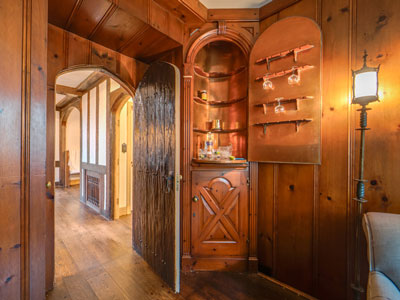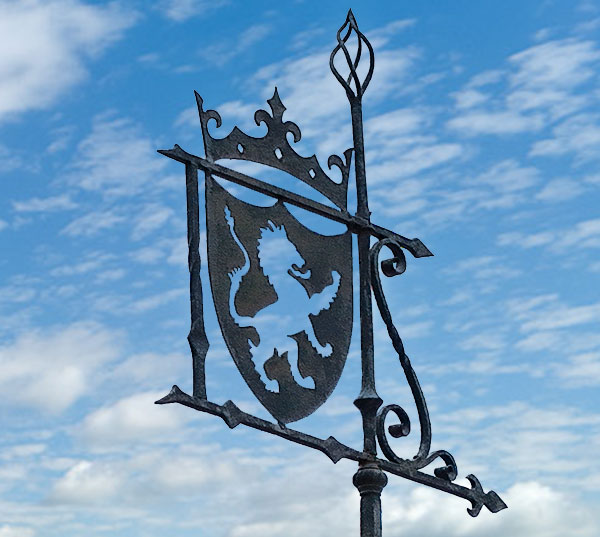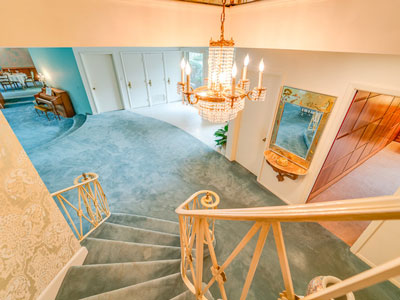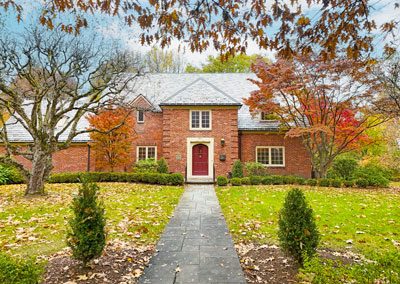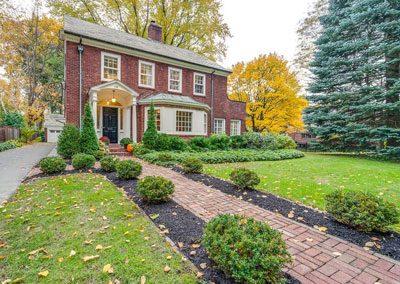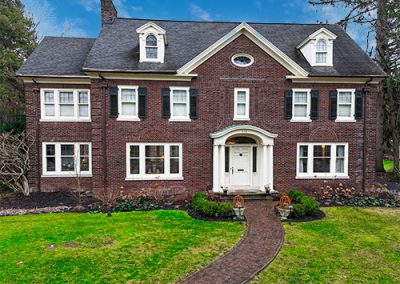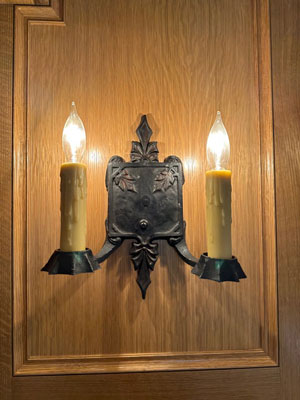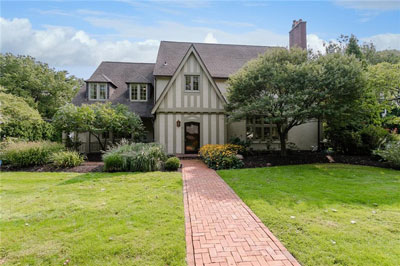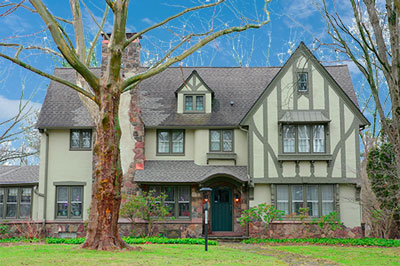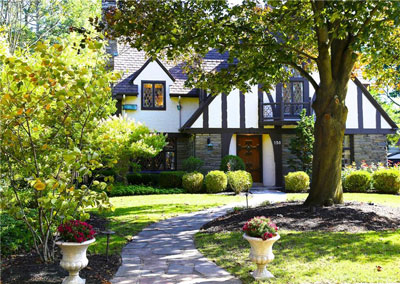Neighborhoods ➤Houston Barnard Subdivision Homes
Love Where You Live
Turn on to the stately streets of Houston Barnard’s first of two prominent suburban developments known as the Houston Barnard Subdivision, and one is quickly enveloped under luscious tree canopies and lovely harp street lamps. This neighborhood encompasses Grosvenor Road, Pelham Road, and Council Rock Avenue, bordered by Highland Avenue to the south and East Avenue to the northeast.
This historic, early twentieth century gem of Brighton is one of many upscale regions designed by prominent real estate developer Houston Barnard beginning in 1918.
“We love welcoming new residents to the neighborhood.”
Like the neighboring Houston Barnard Tract across Clover Street, this subdivision was developed with high minimum house prices, large lots, and forbidden outbuildings (other than one garage).
The Houston Barnard Subdivision encompasses Grosvenor Road, Pelham Road, and Council Rock Avenue, bordered by Highland Avenue (to the south and East Avenue to the northeast).
To learn more about the Houston Barnard Tract, encompassing Ambassador Drive, Sandringham Road, Elm Lane, Georgian Court Road, Trevor Court Road and Esplanade Drive (east of Clover Street), please visit our Houston Barnard Tract page.
Architecture & Design
However, architectural design was not standardized nor restricted, allowing famous architects like Leander McCord and Ward Wellington Ward to take creative agency in craftsmanship and embark on very personalized designs in close correspondence with their trailblazing corporate executive clients. Thus, the subdivision boasts a great diversity in styles, from impressive Craftsman manors to majestic, eclectic Tudor Revivals with steep, dormer decorated roof pitches and opulent brickwork and masonry. The detailed work of a 1920s influx in Italian master craftsmen, alongside the war-stalled, drawn-out purchasing of lots, make for a very architecturally diverse presentation of styles, proportions, and textures. Most homes boast impressive grounds and sculptures curated by master gardeners.
Details & Craftsmanship
Leaded glass windows, generous wood wainscoting, intricate brick and marble tilework, gables, and elaborate porticos and balustrades are some of many features that define this master work. Famous tilemaker Henry Chapman Mercer of Moravian Pottery and Tile Works in Doylestown, PA and Henry Keck of Pike Stained Glass Studios are some of these expert craftsmen.
Ward, like many other residential architects, followed the tenets of an English cottage facade: apparently small, unassuming, with minimal dormers. None of these homes were actually small, however, but their humble facades added to the appeal of finding grandiosity as one circles or enters each house. Conveniently, homeowners and guests could celebrate this grandiosity from the coziness of alcoves and nooks that architects like Ward employed to break up the traditional four-square plan.
Thus, many of the homes of the Houston Barnard Subdivision can be marveled for their grandiosity while cherished for their humble intentions following the Arts and Crafts mantra “The small house made into art.” Ward Wellington Ward exemplified the selective, eclectic style of the Subdivision, with inspiration ranging from Arts & Crafts to American vernaculars like Colonial New England and Frank Lloyd Wright’s Midwest Prairie School.
Ward Wellington Ward
Ward Wellington Ward, though most prominent in Syracuse, created a collection of designs in Brighton. For example, Ward designed Nos. 42, 75, 165, 168, and 191 Grosvenor Road and Nos. 40, 110, 115, 125, 150, 155, and 165 Pelham Road in Brighton.
Ward was famous for his quick pen and watercolor sketches of home exteriors that Irving Hames, Houston Barnard’s salesman, could pitch to prospective inhabitants.
Houston Barnard’s network of architects embraced elements of the Arts and Crafts style, a movement conceived in the mid 19th century by William Morris to oppose the streamlined, drab housing manufacturing born of the Industrial Revolution. Morris, like any other proponent of Arts Nouveau or Art Deco, valued the individualized hand craftsmanship of the Medieval Age. Architects like Ward applied this doctrine to their Tudoresque homes that fill most of the Houston Barnard Subdivision.
Artistic Influences
Leaded glass windows, generous wood wainscoting, intricate brick and marble tilework, gables, and elaborate porticos and balustrades are some of many features that define this master work. Famous tilemaker Henry Chapman Mercer of Moravian Pottery and Tile Works in Doylestown, PA and Henry Keck of Pike’s Stained Glass Studio are some of these expert craftsmen.
Ward, like many other residential architects, followed the tenets of an English cottage facade: apparently small, unassuming, with minimal dormers. None of these homes were actually small, however, but their humble facades added to the appeal of finding grandiosity as one circles or enters each house.
Conveniently, homeowners and guests could celebrate this grandiosity from the coziness of alcoves and nooks that architects like Ward employed to break up the traditional four-square plan. Thus, many of the homes of the Houston Barnard Subdivision can be marveled for their grandiosity while cherished for their humble intentions following the Arts and Crafts mantra “The small house made into art.” Ward Wellington Ward exemplified the selective, eclectic style of the Subdivision, with inspiration ranging from Arts & Crafts to American vernaculars like Colonial New England and Frank Lloyd Wright’s Midwest Prairie School.
Leander McCord & Others
A recent exploration of Leander McCord has revealed nearly seventy Tudor Revival works, many of which inhabit the Houston Barnard Subdivision. One could argue that McCord’s mastery of intricate design features exceeds the skills of Ward Wellington Ward and his mentor, J. Foster Warner.
The houses designed by McCord in the Subdivision include:
- 138, 154, 162, 172, 190 Council Rock Avenue
- 1, 151 Grosvenor Road
- 2, 55, 60, 61 Pelham Road

Historical Style
Both Houston Barnard neighborhoods had roads, curbs, sidewalks, and harp-shaped street lamps installed before many of the homes were constructed.
One might notice that several of the Subdivision’s homes are split-level, prairie-style ranches (many designed by notable Rochester architect Don Hershey). These were built in decades following the Great Depression, where development of the Subdivision slowed considerably. For example, during the 1930s, in the separate Council Rock Estates (south of Highland), all of Houston Barnard’s street appurtenances (lighting, curbs, sidewalks, etc.) were in place but the lots were empty. This was due to the nature of the economy at the time and Houston Barnard’s spiral from a 5-million-dollar net worth to just $2000 at the time of his death in 1936. However, in a post-World War II boom, the remaining empty lots were filled in, adding a new degree of architectural diversity to the Subdivision.
Love Where You Live
Turn on to the stately streets of Houston Barnard’s first of two prominent suburban developments known as the Houston Barnard Subdivision, and one is quickly enveloped under luscious tree canopies and lovely harp street lamps. This neighborhood encompasses Grosvenor Road, Pelham Road, and Council Rock Avenue, bordered by Highland Avenue to the south and East Avenue to the northeast.
This historic, early twentieth century gem of Brighton is one of many upscale regions designed by prominent real estate developer Houston Barnard beginning in 1918. Like the neighboring Houston Barnard Tract across Clover Street, this subdivision was developed with high minimum house prices, large lots, and forbidden outbuildings (other than one garage).
The Houston Barnard Subdivision encompasses Grosvenor Road, Pelham Road, and Council Rock Avenue, bordered by Highland Avenue (to the south and East Avenue to the northeast).
To learn more about the Houston Barnard Tract, encompassing Ambassador Drive, Sandringham Road, Elm Lane, Georgian Court Road, Trevor Court Road and Esplanade Drive (east of Clover Street), please visit our Houston Barnard Tract page.
We love welcoming new residents to the neighborhood.”
Red Ribbon Key video
Medieval Mansion video
HB Subdivision Design
However, architectural design was not standardized nor restricted, allowing famous architects like Leander McCord and Ward Wellington Ward to take creative agency in craftsmanship and embark on very personalized designs in close correspondence with their trailblazing corporate executive clients. Thus, the subdivision boasts a great diversity in styles, from impressive Craftsman manors to majestic, eclectic Tudor Revivals with steep, dormer decorated roof pitches and opulent brickwork and masonry. The detailed work of a 1920s influx in Italian master craftsmen, alongside the war-stalled, drawn-out purchasing of lots, make for a very architecturally diverse presentation of styles, proportions, and textures. Most homes boast impressive grounds and sculptures curated by master gardeners.
Details & Craftsmanship
Leaded glass windows, generous wood wainscoting, intricate brick and marble tilework, gables, and elaborate porticos and balustrades are some of many features that define this master work. Famous tilemaker Henry Chapman Mercer of Moravian Pottery and Tile Works in Doylestown, PA and Henry Keck of Pike Stained Glass Studios are some of these expert craftsmen.
Ward, like many other residential architects, followed the tenets of an English cottage facade: apparently small, unassuming, with minimal dormers. None of these homes were actually small, however, but their humble facades added to the appeal of finding grandiosity as one circles or enters each house. Conveniently, homeowners and guests could celebrate this grandiosity from the coziness of alcoves and nooks that architects like Ward employed to break up the traditional four-square plan.
Thus, many of the homes of the Houston Barnard Subdivision can be marveled for their grandiosity while cherished for their humble intentions following the Arts and Crafts mantra “The small house made into art.” Ward Wellington Ward exemplified the selective, eclectic style of the Subdivision, with inspiration ranging from Arts & Crafts to American vernaculars like Colonial New England and Frank Lloyd Wright’s Midwest Prairie School.
Ward Wellington Ward
Ward Wellington Ward, though most prominent in Syracuse, created a collection of designs in Brighton. For example, Ward designed Nos. 42, 75, 165, 168, and 191 Grosvenor Road and Nos. 40, 110, 115, 125, 150, 155, and 165 Pelham Road in Brighton.
Ward was famous for his quick pen and watercolor sketches of home exteriors that Irving Hames, Houston Barnard’s salesman, could pitch to prospective inhabitants.
Houston Barnard’s network of architects embraced elements of the Arts and Crafts style, a movement conceived in the mid 19th century by William Morris to oppose the streamlined, drab housing manufacturing born of the Industrial Revolution. Morris, like any other proponent of Arts Nouveau or Art Deco, valued the individualized hand craftsmanship of the Medieval Age. Architects like Ward applied this doctrine to their Tudoresque homes that fill most of the Houston Barnard Subdivision.
Artistic Influences
Leaded glass windows, generous wood wainscoting, intricate brick and marble tilework, gables, and elaborate porticos and balustrades are some of many features that define this master work. Famous tilemaker Henry Chapman Mercer of Moravian Pottery and Tile Works in Doylestown, PA and Henry Keck of Pike’s Stained Glass Studio are some of these expert craftsmen.
Ward, like many other residential architects, followed the tenets of an English cottage facade: apparently small, unassuming, with minimal dormers. None of these homes were actually small, however, but their humble facades added to the appeal of finding grandiosity as one circles or enters each house. Conveniently, homeowners and guests could celebrate this grandiosity from the coziness of alcoves and nooks that architects like Ward employed to break up the traditional four-square plan.
Thus, many of the homes of the Houston Barnard Subdivision can be marveled for their grandiosity while cherished for their humble intentions following the Arts and Crafts mantra “The small house made into art.” Ward Wellington Ward exemplified the selective, eclectic style of the Subdivision, with inspiration ranging from Arts & Crafts to American vernaculars like Colonial New England and Frank Lloyd Wright’s Midwest Prairie School.
Leander McCord & Others
A recent exploration of Leander McCord has revealed nearly seventy Tudor Revival works, many of which inhabit the Houston Barnard Subdivision. One could argue that McCord’s mastery of intricate design features exceeds the skills of Ward Wellington Ward and his mentor, J. Foster Warner.
The houses designed by McCord in the Subdivision include:
- 138, 154, 162, 172, 190 Council Rock Avenue
- 1, 151 Grosvenor Road
- 2, 55, 60, 61 Pelham Road
Historical Style
Both Houston Barnard neighborhoods had roads, curbs, sidewalks, and harp-shaped street lamps installed before many of the homes were constructed.
One might notice that several of the Subdivision’s homes are split-level, prairie-style ranches (many designed by notable Rochester architect Don Hershey). These were built in decades following the Great Depression, where development of the Subdivision slowed considerably. For example, during the 1930s, in the separate Council Rock Estates (south of Highland), all of Houston Barnard’s street appurtenances (lighting, curbs, sidewalks, etc.) were in place but the lots were empty. This was due to the nature of the economy at the time and Houston Barnard’s spiral from a 5-million-dollar net worth to just $2000 at the time of his death in 1936. However, in a post-World War II boom, the remaining empty lots were filled in, adding a new degree of architectural diversity to the Subdivision.

1924 Tudor home with Exterior Makeover – Houston Barnard Subdivision
1924 Tudor with Exterior Makeover
Love Where You Live
Turn on to the stately streets of Houston Barnard’s first of two prominent suburban developments known as the Houston Barnard Subdivision, and one is quickly enveloped under luscious tree canopies and lovely harp street lamps. This neighborhood encompasses Grosvenor Road, Pelham Road, and Council Rock Avenue, bordered by Highland Avenue to the south and East Avenue to the northeast.
This historic, early twentieth century gem of Brighton is one of many upscale regions designed by prominent real estate developer Houston Barnard beginning in 1918.
Like the neighboring Houston Barnard Tract across Clover Street, this subdivision was developed with high minimum house prices, large lots, and forbidden outbuildings (other than one garage).
The Houston Barnard Subdivision encompasses Grosvenor Road, Pelham Road, and Council Rock Avenue, bordered by Highland Avenue (to the south and East Avenue to the northeast).
To learn more about the Houston Barnard Tract, encompassing Ambassador Drive, Sandringham Road, Elm Lane, Georgian Court Road, Trevor Court Road and Esplanade Drive (east of Clover Street), please visit our Houston Barnard Tract page.
1924 Tudor home with Exterior Makeover – Houston Barnard Subdivision
1924 Tudor with Exterior Makeover
Architecture & Design
However, architectural design was not standardized nor restricted, allowing famous architects like Leander McCord and Ward Wellington Ward to take creative agency in craftsmanship and embark on very personalized designs in close correspondence with their trailblazing corporate executive clients.
Thus, the subdivision boasts a great diversity in styles, from impressive Craftsman manors to majestic, eclectic Tudor Revivals with steep, dormer decorated roof pitches and opulent brickwork and masonry. The detailed work of a 1920s influx in Italian master craftsmen, alongside the war-stalled, drawn-out purchasing of lots, make for a very architecturally diverse presentation of styles, proportions, and textures. Most homes boast impressive grounds and sculptures curated by master gardeners.
Details & Craftsmanship
Leaded glass windows, generous wood wainscoting, intricate brick and marble tilework, gables, and elaborate porticos and balustrades are some of many features that define this master work. Famous tilemaker Henry Chapman Mercer of Moravian Pottery and Tile Works in Doylestown, PA and Henry Keck of Pike Stained Glass Studios are some of these expert craftsmen.
Ward, like many other residential architects, followed the tenets of an English cottage facade: apparently small, unassuming, with minimal dormers. None of these homes were actually small, however, but their humble facades added to the appeal of finding grandiosity as one circles or enters each house. Conveniently, homeowners and guests could celebrate this grandiosity from the coziness of alcoves and nooks that architects like Ward employed to break up the traditional four-square plan.
Thus, many of the homes of the Houston Barnard Subdivision can be marveled for their grandiosity while cherished for their humble intentions following the Arts and Crafts mantra “The small house made into art.” Ward Wellington Ward exemplified the selective, eclectic style of the Subdivision, with inspiration ranging from Arts & Crafts to American vernaculars like Colonial New England and Frank Lloyd Wright’s Midwest Prairie School.
Ward Wellington Ward
Ward Wellington Ward, though most prominent in Syracuse, created a collection of designs in Brighton. For example, Ward designed Nos. 42, 75, 165, 168, and 191 Grosvenor Road and Nos. 40, 110, 115, 125, 150, 155, and 165 Pelham Road in Brighton.
Ward was famous for his quick pen and watercolor sketches of home exteriors that Irving Hames, Houston Barnard’s salesman, could pitch to prospective inhabitants.
Houston Barnard’s network of architects embraced elements of the Arts and Crafts style, a movement conceived in the mid 19th century by William Morris to oppose the streamlined, drab housing manufacturing born of the Industrial Revolution. Morris, like any other proponent of Arts Nouveau or Art Deco, valued the individualized hand craftsmanship of the Medieval Age. Architects like Ward applied this doctrine to their Tudoresque homes that fill most of the Houston Barnard Subdivision.
Artistic Influences
Leaded glass windows, generous wood wainscoting, intricate brick and marble tilework, gables, and elaborate porticos and balustrades are some of many features that define this master work. Famous tilemaker Henry Chapman Mercer of Moravian Pottery and Tile Works in Doylestown, PA and Henry Keck of Pike’s Stained Glass Studio are some of these expert craftsmen.
Ward, like many other residential architects, followed the tenets of an English cottage facade: apparently small, unassuming, with minimal dormers. None of these homes were actually small, however, but their humble facades added to the appeal of finding grandiosity as one circles or enters each house. Conveniently, homeowners and guests could celebrate this grandiosity from the coziness of alcoves and nooks that architects like Ward employed to break up the traditional four-square plan.
Thus, many of the homes of the Houston Barnard Subdivision can be marveled for their grandiosity while cherished for their humble intentions following the Arts and Crafts mantra “The small house made into art.” Ward Wellington Ward exemplified the selective, eclectic style of the Subdivision, with inspiration ranging from Arts & Crafts to American vernaculars like Colonial New England and Frank Lloyd Wright’s Midwest Prairie School.
Leander McCord & Others
A recent exploration of Leander McCord has revealed nearly seventy Tudor Revival works, many of which inhabit the Houston Barnard Subdivision. One could argue that McCord’s mastery of intricate design features exceeds the skills of Ward Wellington Ward and his mentor, J. Foster Warner.
The houses designed by McCord in the Subdivision include:
- 138, 154, 162, 172, 190 Council Rock Avenue
- 1, 151 Grosvenor Road
- 2, 55, 60, 61 Pelham Road
Historical Style
Both Houston Barnard neighborhoods had roads, curbs, sidewalks, and harp-shaped street lamps installed before many of the homes were constructed.
One might notice that several of the Subdivision’s homes are split-level, prairie-style ranches (many designed by notable Rochester architect Don Hershey). These were built in decades following the Great Depression, where development of the Subdivision slowed considerably. For example, during the 1930s, in the separate Council Rock Estates (south of Highland), all of Houston Barnard’s street appurtenances (lighting, curbs, sidewalks, etc.) were in place but the lots were empty. This was due to the nature of the economy at the time and Houston Barnard’s spiral from a 5-million-dollar net worth to just $2000 at the time of his death in 1936. However, in a post-World War II boom, the remaining empty lots were filled in, adding a new degree of architectural diversity to the Subdivision.

Buying or Selling in HB?
Tap into Jamie’s superpowers!
Having listed and/or sold properties in the Houston Barnard Subdivision for over four decades, Jamie’s record of success translates into:
- A discreet matchmaking service connecting her team’s HB waiting list of clients with upcoming HB homes for sale.
- Wisdom regarding relative property choices, values, assessments, list and sale prices, quality contractors and professionals and future connections, personal and professional.

- Jamie Columbus
- CEO/Broker
- 585 • 259 • 9139
Email Jamie
Love Letters
Jamie Columbus is a brilliant marketing professional. As our real estate agent, she spent quality time with us to ensure a thorough understanding of our objectives, and presented our home in the best way possible. Her knowledge of the Houston Barnard neighborhood is unmatched, and adds value to the prospective homeowner.
Most importantly, you were practically a miracle worker in putting together a team of people to do all the necessary fix ups and used your artist’s eye to prepare our house to look its best and market it to attract buyers. Your incredible energy and enthusiasm for our house and our neighborhood kept us upbeat, and focused.
Jamie’s negotiation skills are second to none…from a starter home to a lake house, to a seven-figure estate, Jamie has led us to one successful transaction after another. Her inside knowledge of all of the happenings in the HB neighborhood has provided us with numerous opportunities that we would not have had if we worked with a different agent. Jamie has been able to show us both interior and exteriors of several homes in this neighborhood based on her relationship with previous clients and friends in the area. We firmly believe that she is the ideal person to work with if you are looking to get into the HB neighborhood.


